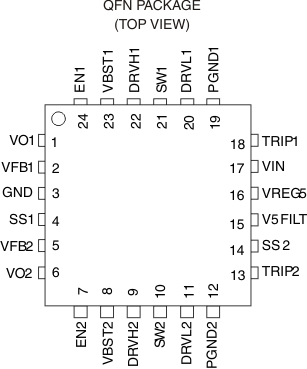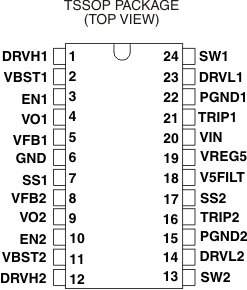SLVSAE4A July 2010 – August 2014 TPS53128
PRODUCTION DATA.
- 1 Features
- 2 Applications
- 3 Description
- 4 Revision History
- 5 Pin Configuration and Functions
- 6 Specifications
-
7 Detailed Description
- 7.1 Overview
- 7.2 Functional Block Diagram
- 7.3
Feature Description
- 7.3.1 PWM Operation
- 7.3.2 Light-Load Condition
- 7.3.3 Drivers
- 7.3.4 PWM Frequency And Adaptive On-Time Control
- 7.3.5 5-Volt Regulator
- 7.3.6 Soft Start
- 7.3.7 Pre-Bias Support
- 7.3.8 Output Discharge Control
- 7.3.9 Over Current Limit
- 7.3.10 Over/Under Voltage Protection
- 7.3.11 UVLO Protection
- 7.3.12 Thermal Shutdown
- 7.4 Device Functional Modes
- 8 Application and Implementation
- 9 Power Supply Recommendations
- 10Layout
- 11Device and Documentation Support
- 12Mechanical, Packaging, and Orderable Information
Package Options
Mechanical Data (Package|Pins)
Thermal pad, mechanical data (Package|Pins)
- RGE|24
Orderable Information
5 Pin Configuration and Functions


Table 2. Pin Functions
| PIN | I/O | DESCRIPTION | ||
|---|---|---|---|---|
| NAME | RGE | PW | ||
| VBST1, VBST2 | 23, 8 | 2, 11 | I | Supply input for high-side NFET driver. Bypass to SWx with a high-quality 0.1-μF ceramic capacitor. An external schottky diode can be added from VREG5 if forward drop is critical to drive the high-side FET. |
| EN1, EN2 | 24, 7 | 3, 10 | I | Enable. Pull High to enable SMPS. |
| VO1, VO2 | 1, 6 | 4, 9 | I | Output voltage inputs for on-time adjustment and output discharge. Connect directly to the output voltage. |
| VFB1, VFB2 | 2, 5 | 5, 8 | I | D-CAP2 feedback inputs. Connect to output voltage with resistor divider. |
| GND | 3 | 6 | I | Signal ground pin. Connect to PGND1, PGND2 and system ground at a single point. |
| DRVH1, DRVH2 | 22, 9 | 1, 12 | O | High-side N-Channel MOSFET gate driver outputs. SWx referenced drivers switch between SWx (OFF) and VBSTx (ON). |
| SW1, SW2 | 21, 10 | 24, 13 | I/O | Switch node connections for both the high-side drivers and the over current comparators. |
| DRVL1, DRVL2 | 20, 11 | 23, 14 | O | Low-side N-Channel MOSFET gate driver outputs. PGND referenced drivers switch between PGNDx (OFF) and VREG5 (ON). |
| PGND1, PGND2 | 19, 12 | 22, 15 | I/O | Power ground connections for both the low-side drivers and the over current comparators. Connect PGND1, PGND2 and GND strongly together near the IC. |
| TRIP1, TRIP2 | 18, 13 | 21, 16 | I | Over current threshold programming pin. Connect to GND with a resistor to GND to set threshold for low-side RDS(ON) current limit. |
| VIN | 17 | 20 | I | Supply Input for 5-V linear regulator. Bypass to GND with a minimum high-quality 0.1-μF ceramic capacitor. |
| V5FILT | 15 | 18 | I | 5-V supply input for the entire control circuitry except the MOSFET drivers. Bypass to GND with a minimum high-quality 1.0-μF ceramic capacitor. V5FILT is connected to VREG5 via an internal 10-Ω resistor. |
| VREG5 | 16 | 19 | O | Output of 5-V linear regulator and supply for MOSFET drivers. Bypass to GND with a minimum high-quality 4.7-μF ceramic capacitor. VREG5 is connected to V5FILT via an internal 10-Ω resistor. |
| SS1, SS2 | 4,14 | 7, 17 | O | Soft-start programming pin. Connect capacitor from SSx pin to GND to program soft-start time. |